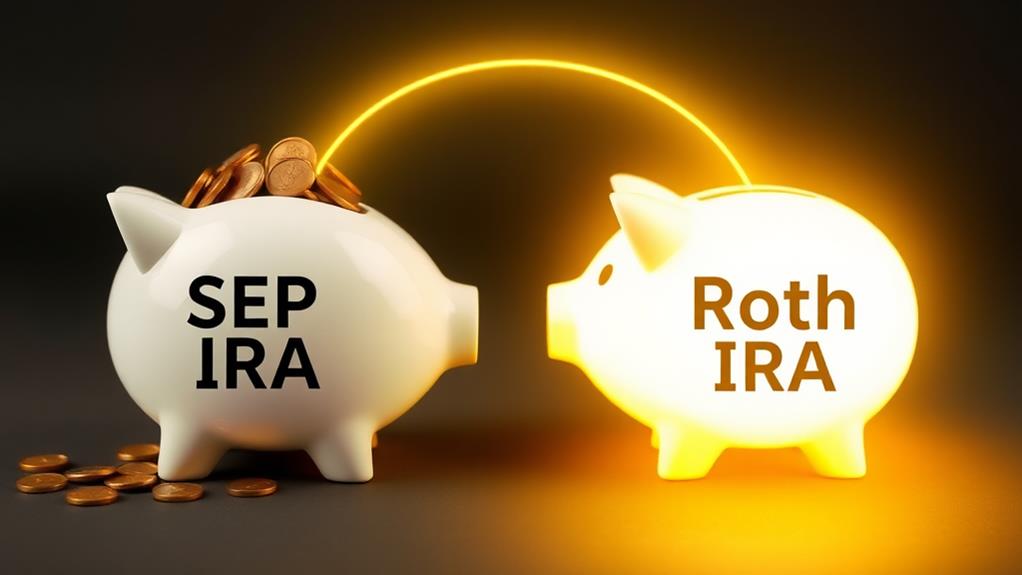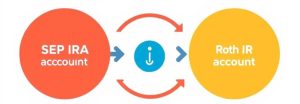Converting a SEP IRA to a Roth IRA can enhance your retirement strategy by offering tax-free growth and withdrawal flexibility. The most straightforward method is a direct transfer, which involves instructing your SEP IRA trustee to move funds directly to your Roth IRA. This approach minimizes risks such as missing the 60-day rollover deadline and incurring penalties. Confirm accurate reporting on IRS Forms 1040 and 8606 to reflect the conversion and manage tax implications. Strategic timing of the conversion can also mitigate the tax burden, positioning you advantageously for retirement. Continue to explore for a more detailed roadmap to a seamless conversion.
Key Takeaways
- Instruct your SEP IRA trustee to transfer funds directly to your Roth IRA to avoid rollover risks.
- Ensure all documentation is accurate and report the conversion on IRS forms 1040 and 8606.
- Notify your SEP IRA trustee of your intent to convert and verify the process.
- Plan the conversion in a lower-income year to minimize tax impact.
- Understand that the conversion amount will be taxed as ordinary income.
Understanding SEP IRA and Roth IRA

Understanding the distinct features of SEP IRA and Roth IRA is vital for individuals considering a shift between these retirement accounts.
A SEP IRA, or Simplified Employee Pension Individual Retirement Account, is tailored for self-employed individuals or small business owners. Contributions to a SEP IRA are based on a percentage of income, allowing for substantial tax-deferred savings. This means that contributions are made pre-tax, reducing the taxable income for the year in which they are made, and taxes are deferred until distributions are taken in retirement.
Conversely, a Roth IRA is funded with after-tax dollars, meaning contributions do not reduce taxable income in the year they are made. However, the significant advantage of a Roth IRA lies in its tax-free growth and withdrawals during retirement, provided certain conditions are met.
When converting a SEP IRA to a Roth IRA, one shifts from a tax-deferred account to a tax-free account, necessitating the payment of taxes on converted amounts. Proper tax reporting during this conversion is pivotal to comply with IRS regulations and avoid potential penalties. Additionally, understanding the tax implications, timing, and future distribution rules is paramount to making an informed decision.
Benefits of Converting to Roth IRA
Converting a SEP IRA to a Roth IRA offers multiple advantages that can greatly enhance long-term retirement planning. One of the primary benefits is the ability to enjoy tax-free qualified distributions during retirement. Unlike traditional retirement accounts, Roth IRAs allow for tax-free growth, meaning the investments within the account can grow without being subject to annual taxes. This benefit extends to withdrawals as well, provided certain conditions are met, giving account holders significant tax relief in their retirement years.
Diversifying retirement account types by converting to a Roth IRA also aids in managing future tax liabilities. This strategy is particularly advantageous for individuals who anticipate being in a higher tax bracket in the future. By paying taxes on the conversion now, they can potentially save on taxes later when their income and tax rates might be higher.
Another notable benefit is that Roth IRAs are not subject to required minimum distributions (RMDs) during the account holder’s lifetime. This feature grants more control over the timing and amount of withdrawals, allowing for greater flexibility in retirement planning.
Conversion Methods: Rollover Vs. Transfer
When considering the conversion of a SEP IRA to a Roth IRA, understanding the two primary methods available is pivotal: rollover and transfer.
The rollover method involves taking a distribution from your SEP IRA and depositing it into your Roth IRA within 60 days. This method requires meticulous attention to the deadline; missing the 60-day window can result in significant tax implications and potential penalties. Additionally, the distribution may be subject to income tax withholding, complicating the process further.
On the other hand, the transfer method requires instructing the trustee of your SEP IRA to move funds directly to your Roth IRA. This approach is generally recommended to avoid the risks associated with the rollover method. By choosing the transfer method, you eliminate the possibility of missing the 60-day deadline and can sidestep the complications of income tax withholding.
Regardless of the method chosen, it is important to note that the amount converted will be treated as taxable income in the year of the switch. Hence, careful planning and execution are vital to ensure a smooth and tax-efficient conversion process.
Why Choose the Transfer Method
Choosing the conversion method for converting a SEP IRA to a Roth IRA offers significant advantages, such as the direct transfer of funds between trustees, which mitigates the risk of missing the 60-day rollover deadline. This approach also bypasses any potential income tax withholding, ensuring a more straightforward and tax-efficient conversion. By opting for the conversion method, you can achieve a seamless switch, minimizing complications and avoiding common pitfalls associated with the rollover process.
Direct Transfer Benefits
Opting for the direct switch method when converting a SEP IRA to a Roth IRA offers several compelling benefits that streamline the process. This method involves moving funds directly from one account to another, bypassing the need for any distribution to the account holder.
One of the primary advantages of this approach is the elimination of the risk associated with missing the 60-day deadline important to the rollover method, thereby mitigating potential tax consequences.
By instructing the trustee to transfer the funds directly, account holders can guarantee a seamless and efficient conversion. This not only simplifies the process but also provides peace of mind knowing that the funds are securely transferred without unnecessary complications.
Moreover, direct transfers are not subject to income tax withholding, which is a significant benefit for those looking to maintain full control over their assets.
The direct switch method is a recommended strategy for those seeking a hassle-free, tax-efficient change from a SEP IRA to a Roth IRA. It effectively minimizes administrative burdens and reduces the complexity involved in managing retirement funds, making it an excellent choice for individuals who prioritize control and efficiency in their financial planning.
Avoiding Tax Withholding
A primary advantage of the transfer method when converting a SEP IRA to a Roth IRA is the ability to avoid income tax withholding on the conversion amount. By opting for a direct exchange, you can instruct the SEP IRA trustee to move funds directly to the Roth IRA trustee, guaranteeing that no portion of the funds is withheld for taxes. This approach allows for a seamless and efficient conversion process, minimizing unnecessary tax consequences and giving you greater control over your financial strategy.
Choosing the transfer method also mitigates the risk of missing the critical 60-day rollover deadline. Should you miss this deadline, the rollover amount would be treated as a taxable distribution, potentially subjecting you to additional tax liabilities and penalties. Direct exchanges eliminate this risk by guaranteeing that the funds are moved promptly and correctly, aligning with IRS guidelines.
Furthermore, direct exchanges are recommended for their simplicity and reliability. They streamline the conversion process, making it less cumbersome and more straightforward, thereby preventing administrative errors that could lead to costly tax implications. Opting for the transfer method ensures a smooth shift, preserving the integrity of your retirement savings and maintaining your financial control.
Steps for Transfer Method Conversion

To start the transformation of a SEP IRA to a Roth IRA using the transfer method, first notify the trustee overseeing the SEP IRA of your decision. This initial step informs the trustee of your intent and can help facilitate the process smoothly. It is essential to instruct the trustee to transfer the funds directly to your Roth IRA account to bypass the 60-day limit and potential tax implications associated with indirect rollovers.
Next, carefully verify that all documentation and reporting needed for the conversion are accurately completed. Proper documentation ensures that the IRS is informed of the transaction, hence avoiding any future discrepancies.
The timing of the transfer plays a significant role in determining when you can access the funds within your Roth IRA. Therefore, strategize the timing wisely to align with your financial goals.
Key steps include:
- Inform the SEP IRA trustee about the conversion decision.
- Instruct the trustee for direct transfer of funds to avoid the 60-day deadline.
- Guarantee thorough documentation and reporting for tax purposes.
Tax Implications of Conversion
Converting a SEP IRA to a Roth IRA leads to an increase in taxable income for the year the conversion occurs, as the amount converted is taxed as ordinary income. Accurate reporting on IRS forms 1040 and 8606 is essential to guarantee compliance and avoid potential penalties. Individuals should carefully consider how this taxable event impacts their overall financial situation, especially regarding income level and tax bracket.
Taxable Income Increase
Upon converting a SEP IRA to a Roth IRA, individuals should be aware that the conversion amount will be treated as taxable income for that tax year. This inclusion can have a significant impact on one’s tax liability, especially since contributions to SEP IRAs are not taxed initially, but the conversion amount is taxed as ordinary income. Understanding this can help individuals manage their tax obligations effectively.
Key considerations include:
- Tax Bracket Impact: The conversion amount will be added to your gross income, potentially pushing you into a higher tax bracket and increasing your overall tax rate.
- Entire Amount Taxable: Generally, the total amount transferred from the SEP IRA to the Roth IRA is subject to taxation, affecting your taxable income for that year.
- Strategic Timing: Converting in a year when your income is lower can minimize the tax burden, allowing you to take advantage of lower tax rates.
Being mindful of these factors ensures that individuals can make informed decisions about when and how to convert their SEP IRA to a Roth IRA, maintaining control over their financial outcomes.
Properly managing this taxable income increase is important for minimizing any adverse tax consequences, thereby optimizing the benefits of the conversion.
Reporting Requirements
Understanding the reporting requirements for converting a SEP IRA to a Roth IRA is vital to guarantee compliance with IRS regulations. The conversion amount is considered as taxable income in the year it occurs. While contributions to a SEP IRA are typically tax-deferred, converting these funds to a Roth IRA means they are subject to ordinary income tax.
To guarantee proper reporting, include the taxable amount from the conversion on Form 1040 or 1040A during tax filing. Additionally, Form 8606 is essential as it helps determine the taxable portion of the conversion, which is generally the entire converted amount. Accurate completion of these forms is crucial to avoid potential penalties and ensure compliance with IRS regulations.
Here is a concise summary in table format:
| Requirement | Tax Form | Details |
|---|---|---|
| Conversion Amount | Form 1040/1040A | Report as taxable income |
| Taxable Income | Form 1040/1040A | Ordinary income tax rate applies |
| Determine Taxable Portion | Form 8606 | Typically, the entire conversion amount |
| Compliance | Form 1040/8606 | Avoid penalties by accurate reporting |
| Filing Deadline | Form 1040/1040A | Align with annual tax filing deadlines |
Properly managing these reporting requirements ensures a smooth shift from a SEP IRA to a Roth IRA, allowing you to maintain control over your financial planning and tax obligations.
Reporting the Conversion on Taxes
Accurately reporting the conversion of a SEP IRA to a Roth IRA on your taxes is essential for compliance with IRS regulations. Ensuring that the conversion is correctly documented on your tax return will prevent potential penalties and provide clarity on your tax obligations.
The primary forms used for this purpose are Form 1040 or 1040A, where you should report the full conversion amount as a nontaxable IRA distribution.
To accurately calculate and report the taxable portion of your conversion, you will need to complete Form 8606. This form is vital as it helps delineate the taxable income resulting from the conversion. Generally, the entire amount converted from a SEP IRA to a Roth IRA is considered taxable in the year the conversion occurs.
Here are key steps to follow:
- Form 1040 or 1040A: Report the total conversion amount as a nontaxable distribution.
- Form 8606: Calculate and report the taxable portion of the conversion.
- Taxable Income: Typically, the entire conversion amount will be included as taxable income for the year.
Forms Required for Reporting
When reporting a SEP IRA to Roth IRA conversion, it is important to use the correct forms to maintain compliance with IRS regulations and avoid any potential penalties. The primary forms required are Form 1040 or 1040A, which should be filed during your annual tax return. On this form, the entire conversion amount should be accurately reported as a nontaxable IRA distribution. Making sure this is done correctly is essential for precise tax calculations.
In addition to Form 1040 or 1040A, Form 8606 plays a crucial role in delineating the taxable portion of the conversion. This form helps determine how much of the converted amount is subject to taxation, typically treating the entire converted sum as ordinary income. Properly completing Form 8606 is important for compliance with IRS mandates and to make certain that all taxable amounts are accurately reported.
Timing and Qualified Distributions

After ensuring all necessary forms are accurately completed for reporting purposes, attention must be given to the timing and regulations surrounding qualified distributions from your Roth IRA. One of the most important aspects to keep in mind is the mandatory five-year waiting period post-conversion. This rule applies universally, regardless of other distribution eligibility criteria.
Understanding this waiting period is essential for planning when you can access your funds without penalty. Here are the key points to keep in mind:
- Five-Year Rule: You must wait at least five years from the conversion date before taking qualified distributions.
- Conversion Year: The specific year you convert your SEP IRA to a Roth IRA determines when you can begin qualified distributions.
- Universal Application: This five-year rule stands regardless of other qualifying factors, such as age or first-time home purchase.
Potential Risks and Considerations
Managing the conversion of a SEP IRA to a Roth IRA requires a comprehensive understanding of the potential risks and considerations. One major factor to evaluate is the tax implications, as the conversion amount will be treated as taxable income in the year of the switch. This increase in taxable income could potentially push you into a higher tax bracket, hence it’s essential to assess your current income level before proceeding.
Another crucial aspect is the five-year rule, which mandates that converted funds must remain in the Roth IRA for at least five years to qualify for tax-free withdrawals. Failing to adhere to this rule could result in penalties and additional taxes.
Selecting the appropriate method for the conversion—rollover versus transfer—also plays a significant role. Missing deadlines or executing incorrect steps could lead to unintended tax complications.
Moreover, the conversion must be accurately reported on your tax return using Form 1040 or 1040A to guarantee compliance with IRS regulations.
Maximizing Your Retirement Strategy

Considering the potential risks and tax implications associated with converting a SEP IRA to a Roth IRA, it becomes essential to explore how this move can enhance your retirement strategy. Converting a SEP IRA to a Roth IRA can be a strategic decision to maximize your retirement savings and tax advantages. Roth IRAs offer the significant benefit of tax-free distributions in retirement, which can substantially boost your financial security.
To maximize your retirement strategy through this conversion, consider the following steps:
- Understand Tax Implications: Converting to a Roth IRA will incur taxes on the converted amount. Accurately report this transaction to the IRS to avoid penalties and ensure adherence.
- Timing the Conversion: Plan the timing of your conversion carefully. By spreading conversions over multiple years, you can manage your tax bracket and reduce the overall tax burden.
- Consult Professionals: Engage with a financial advisor or tax professional to navigate the complexities of the conversion process. Their expertise can help you make informed decisions that align with your long-term retirement goals.
Frequently Asked Questions
Can I Convert a SEP IRA to a Roth IRA if I Am Still Employed?
Yes, you can convert a SEP IRA to a Roth IRA while still employed. However, verify employer policies on in-service distributions and consult a financial advisor to understand the tax implications and effects on your contribution limits.
Are There Any Age Restrictions for Converting a SEP IRA to a Roth Ira?
There are no age restrictions for converting a SEP IRA to a Roth IRA. This allows individuals of any age to enjoy the flexibility of making such conversions, provided they meet the necessary eligibility requirements.
How Do I Choose the Right Financial Institution for My Roth Ira?
When choosing a financial institution for a Roth IRA, assess their reputation, compare fees, evaluate investment options, and guarantee robust customer service. Additionally, consider any special promotions or bonuses that may enhance your financial decision.
What Fees Might Be Associated With Converting My SEP IRA to a Roth Ira?
When converting a SEP IRA to a Roth IRA, potential fees may include transaction, account closure, or transfer fees. These costs vary by financial institution and transfer amount. Confirm all fees with your institution to accurately assess the conversion’s total cost.
Can I Convert Only a Portion of My SEP IRA to a Roth Ira?
Yes, you can convert only a portion of your SEP IRA to a Roth IRA. This approach allows you to manage taxable income, optimize your financial situation, and test the impact on your overall financial plan before full conversion.
Conclusion
Converting a SEP IRA to a Roth IRA can offer significant tax advantages and greater financial flexibility in retirement. By understanding the benefits and choosing the appropriate conversion method, such as a transfer, individuals can navigate the process more efficiently. Adhering to the proper steps, completing necessary forms, and being mindful of timing and potential risks will help in maximizing retirement strategies. This conversion can be a strategic move for enhancing long-term financial security.

